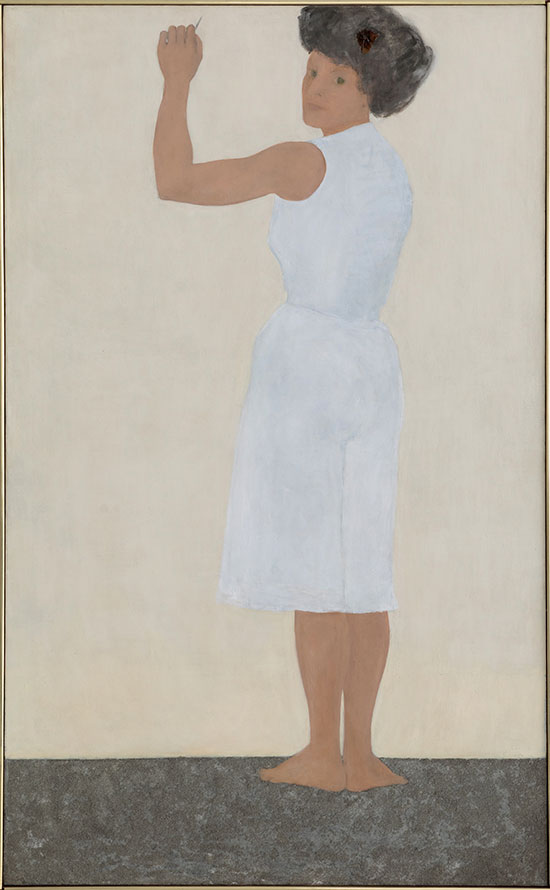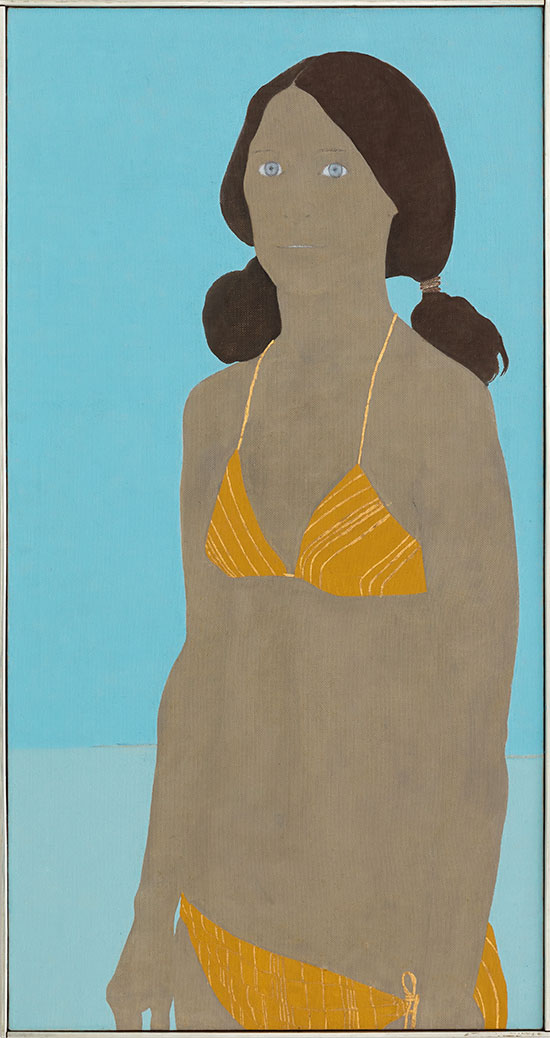In a New York Times review of the show “Inventing Downtown: Artist-Run Galleries in New York City, 1952-1965” at NYU’s Grey Art Gallery earlier this year, Holland Cotter commended the creative vitality of this overlooked mid-century artistic bohemia. These downtown artists were looking for something stylistically and conceptually different from the Abstract Expressionism extolled by the commercial galleries uptown.
Cotter mentions the painter Marcia Marcus having “a way-ahead-of-its-time self-portrait at the Grey,” but notes that she is “now obscure.” So it is a welcome occurrence that Marcus (b. 1928) is currently the subject of a retrospective at Eric Firestone Gallery in Manhattan. “Role Play: Paintings 1958-1973,” provides a glimpse of that heady downtown world of artistic exploration, and helps to reestablish Marcus as a key figure in New York’s mid-century avant-garde art scene.
Centered on the 1960s, “Role Play” consists of a series of portraits of people from the artist’s world: images of friends, family, and of Marcus herself. But the title of the exhibition is apropos, as the artist’s stylistic approach lends the paintings a stilted, staged quality, as though the subjects are playing their parts in a tale. In the large-scale 1964 canvas Frieze: The Porch, for example, the three principal, larger than life-size figures—the feminist writer and Village Voice critic Jill Johnston, the Abstract Expressionist artist Barbara Forst, and Marcus herself—are arranged in a line in the immediate foreground. They don’t engage with each other but instead look out confidently, almost defiantly, at the viewer.
On the right-hand side, a painted replication of an old black and white photograph of Marcus as a little girl, accompanied by her father, is inset within the composition. Marcus uses traditional perspective here to simulate the scene captured by the camera’s lens, which contrasts starkly with the rest of the painting’s shallow depth of field and its vibrant colors and bold patterning. By representing herself with a pale gray face and wearing a cloak bedecked with a floral motif, Marcus unites these two worlds. It is unclear whether the positioning of her cloak serves to present her young self to contemporary society, or to protect her from it.
Marcus, who was born in New York City and attended NYU, the Cooper Union (along with Alex Katz and Lois Dodd), and the Art Students League, was awarded funding to travel to Florence and Paris in 1961 and 1962 respectively; the artistic influence of the old masters is evident in Frieze and throughout the works included in “Role Play.” In an essay in the catalogue devoted to the exhibition, Jessica Bell Brown describes Frieze as an adaptation of Courbet’s great manifesto of painting, The Artist’s Studio, where Courbet, like Marcus, acts as an intermediary between society and art. The very title of Frieze, alongside its linear layout and shallow depth, also alludes to antique art, most notably the sculptural frieze of the Parthenon.
.

"Frieze: The Porch" by Marcia Marcus, 1964. Oil and collage on canvas, 77 x 115 inches. © Marcia Marcus. Photo: Jenny Gorman. Courtesy of Eric Firestone Gallery.
.
What is revolutionary here is that the subjects of the painting are now unapologetically strong women aware of the transformative parts they have chosen to play in modern life, a declaration reinforced by the staged minimalism of the formal design. Working at a time largely dominated by abstraction, Marcus stands out for looking back at the European figurative tradition. Still, by emphasizing surface and experimenting with reduction, her paintings are decidedly new.
Marcus was involved with some of New York’s early performance-based Happenings, and the self-fashioning, performative possibilities of different surface qualities and textures comes across in a number of the show’s paintings. At times the artist uses a canvas support with a rough, open weave; in other works, collage or gold or silver leaf embellish the setting or the subject’s attire. For the otherwise minimally rendered, Self Portrait in White Dress, which was executed in Provincetown in 1959, Marcus incorporated sand into the ground at her feet and placed a collaged flower in her hair.
.

"Self-Portrait in White Dress" by Marcia Marcus,1959. Oil, sand, and collage on canvas, 60 x 37 inches. © Marcia Marcus. Photo: Jenny Gorman. Courtesy of Eric Firestone Gallery.
.
For many years Marcus spent her summers in Provincetown—Alex Katz, her classmate at the Cooper Union, painted a portrait of her on the beach in the same white outfit—and members of her social circle there make frequent appearances in “Role Play.” In the 1965 portrait of Lucas Samaras—the artist renowned for repeatedly using himself as the subject of his work—he is positioned in the immediate foreground, with hands on his hips, wearing gold-patterned swimming briefs. Surrounded by a golden-hued, abstract landscape, Lucas in the Dunes makes a delightfully odd study of selfhood and appearance.
.

"Lucas in the Dunes" by Marcia Marcus,1965. Oil on canvas, 53 x 35 inches. © Marcia Marcus. Photo: Jenny Gorman. Courtesy of Eric Firestone Gallery.
.
Even more captivatingly odd is the similarly foregrounded beachside portrait of the painter Emily Mason. Emily, 1966, depicts the abstract artist in a vibrant yellow bikini against a reduced background composed of two shades of pale, limpid blue. The slightest waver of a yellow line denotes the horizon. Mason’s skin is painted an unusual grayish color, which, against the blue ground, gives the figure a flat, cardboard-cutout quality.
.

"Emily" by Marcia Marcus,1966. Oil on canvas, 48 x 25 inches. © Marcia Marcus. Photo: Jenny Gorman. Courtesy of Eric Firestone Gallery.
.
This quality is intensified by the minimal modeling used to define Mason’s features: her chin almost dissolves into her neck, and the division between her arms and torso is barely perceptible, the flesh merging into a field of color. Aside from the yellow patches of the bikini, the field is broken only by the slightest indication of a row of teeth and, most strikingly, by the subject’s intense blue eyes. Tellingly, Mason is known for her color field abstractions; it would appear that in these portraits of her fellow artists, Marcus captured not only their likenesses, but also something of their artistic identities.
The notion of identity is also apparent in the portrait that hangs next to Emily. Renoir, 1968, depicts a young black woman magnificently attired in a two-piece orange pantsuit. The sitter (the catalogue essay notes that she was a friend who sometimes babysat for the Marcus family) is here much more fully modeled, and her bodily presence is reinforced by the image of her reflection in a mirror. Painted in the immediate aftermath of the 1960s civil rights movement, and at a time of continued racial and gender inequality, Renoir is a powerful proclamation of a new era in artistic representation.
.

"Renoir" by Marcia Marcus,1968. Oil and silver leaf on canvas, 71 3⁄4 x 42 inches. © Marcia Marcus. Photo: Jenny Gorman. Courtesy of Eric Firestone Gallery.
.
Firestone Gallery’s “Role Play” exhibition provides a welcome insight into the vital world of New York City’s mid-century downtown art scene as seen from the perspective of one of its principal players. And, half a century on from when Marcia Marcus completed these paintings, the issues she raises about identity, gender, race, and the roles that we all play are insistently relevant today.
_______________________
BASIC FACTS: “Marcia Marcus, Role Play: Paintings 1958-1973” is on view October 12 to December 2, 2017 at Eric Firestone Gallery, 4 Great Jones Street, #4, New York, NY 10012. www.ericfirestonegallery.com
_______________________
Copyright 2017 Hamptons Art Hub LLC. All rights reserved.
